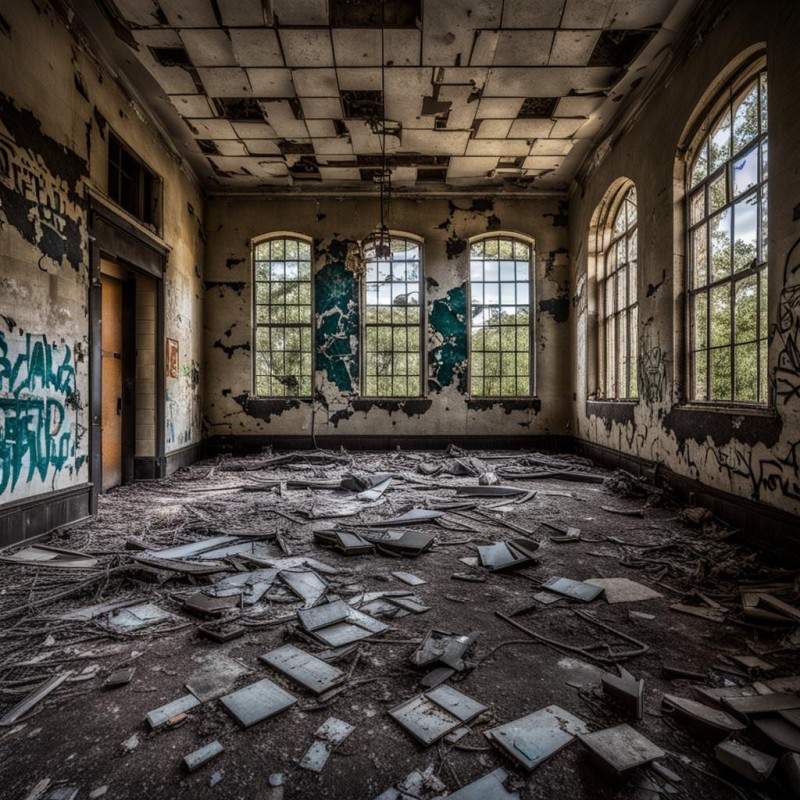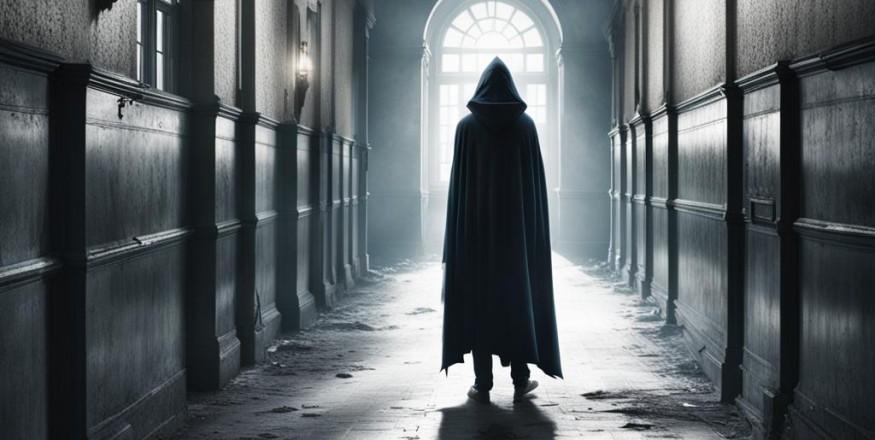 x
x
What you are about to read is one of the most bizarre and frightening chapters in the history of Houston, Texas. Dozens of people have come forward to tell the tale of their experiences inside the old Lone Star High School campus at 1429 Lone Star Grove; twenty-nine were willing to sign affidavits. The tales tell of earthbound spirits and violent, demonic attacks.
This story presented itself to me by fluke. Buck Cassidy was at my place of business filming a TV commercial. A friend of mine asked me how my stories were coming along, and I took that as my cue to show off! I pulled my latest manuscript from my desk and read a few passages aloud.
Buck expressed surprise at my being a writer, and, with a grin, stated the people had been trying to convince him for years that his resort was haunted. He said his wife, employees, and even guests had sworn that they had been victimized by some demonic entity while inside the resort but he had kept it quiet for fear of bad publicity.359Please respect copyright.PENANAmgK76cKXR4
Wanting to learn the facts, I researched old newspapers and local history books. I spent the next two weeks studying the history of the site that the resort sits on, the former site of the Lone Star High School. The unsettling discovery I made about it left me thoroughly disturbed, 359Please respect copyright.PENANAjwgM2HdFvQ
359Please respect copyright.PENANAx8KICztm0R
359Please respect copyright.PENANAMTF945Ha5p
Lone Star High School, founded amidst the burgeoning landscape of Houston in 1960, emerged as a beacon of educational promise, poised to cater to the burgeoning needs of a rapidly expanding population. At its inception, the institution stood as a testament to progress, heralding a new era of scholastic endeavor and communal growth. Embracing a vision rooted in the pursuit of academic distinction and the cultivation of civic involvement, the school embarked on a journey to nurture minds and shape futures. Its architectural embodiment echoed the zeitgeist of the era, boasting sleek lines, expansive windows, and state-of-the-art amenities that symbolized the boundless optimism and forward momentum of the time.
During its formative years, Lone Star High School swiftly garnered acclaim for its distinguished academic accomplishments and its unwavering commitment to extracurricular enrichment. Vibrant school spirit coursed through its corridors, igniting a fervent enthusiasm among its students who eagerly embraced opportunities to excel in sports, arts, and an array of community endeavors. Beyond its walls, Lone Star's influence radiated, casting a bright beacon of educational promise that extended its reach to neighboring communities such as Pepper. In the eyes of these locales, Lone Star stood not only as a paragon of scholastic achievement but also as a cherished symbol of unity, fostering a sense of pride and belonging that transcended geographical boundaries.
As the mid-1960s unfolded, sweeping societal transformations and seismic cultural shifts rippled through the halls of Lone Star High School, leaving an indelible mark on its once-stable landscape. The echoes of the Vietnam War and the thunderous calls for civil rights reverberated within the corridors, sparking impassioned discussions and igniting flames of activism among the student body. Within the school's very heart, fervent debates and occasional protests erupted, as young minds grappled with the weighty issues of war, justice, and equality. These turbulent times served as a crucible, forging bonds of camaraderie amidst the chaos and laying bare the fissures within the school's once-unified fabric. As the tempest of change swept through Lone Star, the familiar rhythms of academic pursuit gave way to a new era of unrest and introspection, heralding the dawn of a transformative chapter in the school's storied history.
With the shifting tides of the late '60s flowing into the dawn of the '70s, Lone Star High School found itself navigating a landscape marked by the emergence of distinct social factions. Within the school's bustling halls, the once-harmonious unity began to fracture, giving rise to the unmistakable delineation of cliques and subcultures. Fueled by the currents of cultural evolution and ideological divergence, tensions simmered beneath the surface, threatening to boil over at any moment. The growing chasm between these disparate groups cast a shadow over the school's once-unified spirit, as whispers of discontent and simmering animosity permeated the air. These early rumblings of discord served as harbingers of greater challenges to come, laying bare the fault lines within the student body and heralding a tumultuous era fraught with confrontation and upheaval.
As economic hardships tightened their grip and tensions simmered between Lone Star High School and its surrounding communities, the once-solid foundation of mutual support began to crack under the strain. The harsh realities of budget constraints cast a pall over the school's extracurricular landscape, forcing difficult decisions and painful cutbacks that reverberated throughout the student body. With beloved programs falling victim to the tightening purse strings, frustration smoldered among students who felt the sting of perceived neglect keenly. As the specter of disenchantment loomed large, a restless energy pulsed through the corridors, fueled by a growing sense of disillusionment and resentment. In the face of adversity, some students turned to rebellion as a means of asserting their discontent, laying bare the fault lines of a community grappling with the harsh realities of economic hardship and strained relationships. The stage was set for the emergence of disruptive behavior, as simmering frustrations boiled over into acts of defiance and defiance, casting a shadow over the once-vibrant spirit of Lone Star High School.
Amidst the backdrop of societal upheaval and cultural flux, the early 1970s ushered in a troubling era of juvenile delinquency within the halls of Lone Star High School. Against the backdrop of shifting social norms and turbulent times, a cohort of students began to veer off course, succumbing to the allure of criminal activities and gang affiliations that held sway within the school's labyrinthine corridors. With each passing day, the specter of violence loomed larger, casting a shadow over the once-hallowed grounds as incidents of misconduct and lawlessness proliferated. The school's administration found itself grappling with an unprecedented challenge, struggling to stem the tide of delinquency that threatened to engulf the institution in chaos. As tensions mounted and tempers flared, the delicate balance between order and anarchy teetered on the brink, plunging Lone Star High School into a downward spiral of deteriorating discipline and disarray.
As the mid-1970s unfolded, the corridors of Lone Star High School became battlegrounds, witnessing a harrowing escalation of violence that sent shockwaves through the very foundation of the institution. No longer confined to mere verbal disputes, conflicts erupted into physical altercations with alarming frequency, leaving a trail of broken bones and shattered trust in their wake. The once-proud pillars of the school's reputation now stood marred by the stain of brutality, as the specter of danger cast a pall over the once-vibrant campus. Weapons, once unthinkable within the confines of a school environment, became all too common tools of intimidation and coercion, turning classrooms into potential war zones and transforming innocent encounters into life-threatening encounters. With each passing day, Lone Star High School drifted further from its lofty ideals, its once-unassailable reputation crumbling beneath the weight of pervasive violence and unchecked aggression. Beyond the school's walls, whispers of its perilous atmosphere spread like wildfire, casting a shadow over the surrounding community and sowing seeds of fear and uncertainty among parents and residents alike. As Lone Star High School grappled with its darkest hour, the urgent question loomed: could it reclaim its lost innocence, or would it be forever tarnished by the scars of its descent into chaos?
Amidst the turmoil of 1977, a sinister whisper crept through the halls of Lone Star High School, weaving a web of fear and suspicion that gripped the very soul of the institution. Rumors, like tendrils of darkness, spread like wildfire, hinting at the existence of a clandestine Satanic cult lurking in the shadows. Tales of occult rituals and arcane symbols whispered in hushed tones sent shivers down the spines of students and staff alike, casting a pall of unease over the once-familiar corridors. While some dismissed these murmurs as nothing more than the fevered imaginings of troubled minds, others found themselves gripped by a gnawing sense of dread, unable to shake the feeling that something malevolent lurked just beyond the veil of perception. As paranoia tightened its grip, a pervasive atmosphere of mistrust took root, fracturing the fragile bonds of camaraderie that had once bound the Lone Star community together. In the face of uncertainty and fear, each whispered rumor served to deepen the shadows that enveloped the school, leaving its inhabitants to navigate a treacherous labyrinth of secrets and lies. And as the specter of the unknown loomed ever larger, Lone Star High School stood on the precipice of an abyss from which there might be no return.
In the twilight years of the 1970s, Lone Star High School was abruptly plunged into darkness, its once bustling halls falling silent in the wake of an unexplained closure that sent shockwaves rippling through the community. While official statements cited escalating violence and dwindling enrollment as the catalysts for the shuttering of the institution, the true reasons behind its demise remained shrouded in secrecy. H.I.S.D.'s steadfast refusal to disclose the full extent of the circumstances surrounding the closure only served to fuel the flames of speculation, leaving the public grasping at shadows in search of answers. Like whispers carried on the wind, rumors swirled through the streets of Houston, painting a picture of intrigue and betrayal that seemed to defy comprehension. Conspiracy theories flourished in the absence of concrete information, each wild speculation serving only to deepen the sense of mystery that cloaked Lone Star High School in an aura of foreboding. As the years passed and the memories of the once-vibrant institution faded into obscurity, the enigma of its sudden closure remained a haunting reminder of the secrets that lie buried beneath the surface of even the most ordinary of places.359Please respect copyright.PENANArTKeTrJInh
359Please respect copyright.PENANAt2uBUvRbNb
359Please respect copyright.PENANABDpXu1j7yO
359Please respect copyright.PENANAe0wUDvBKvs
Buck and Wilma Cassidy were brought into this story in the spring of 1980, when they purchased the building with the intent to renovate it and turn it into a country-western dance/concert hall and musical resort. Carlos Gutierrez was their first employee and is still with them to this day.359Please respect copyright.PENANA0zCSQS94ez
Upon arriving at the resort, I first approached Carlos. I asked him to tell me what he knew about the haunting. His answer was short and direct: "I don't know what you're talking about." He flatly refused to tell me anything at all. After some reassurance and coaxing by Buck, Carlos reluctantly gave in and told me some of the things that he had experienced. I found his tale too bizarre to believe----at first.
I searched high and low for clues that would help me substantiate or refute his story.
Armed with the new information I had gathered, I went back to Carlos. During our earlier meeting, Carlos had purposely omitted certain details that he felt would bring him ridicule, but, after seeing the documentation I had, he opened up and began telling me everything he could remember. After interviewing Carlos, I talked to Wilma Cassidy. What she told me was very frightening. After Wilma, I began talking to the employees and then customers. I found myself lost in a horrifying fairy tale come true. There were just too many people experiencing these strange things while inside the nightclub. After completing the interviews and investigation, I took a long hard look at the evidence that Buck Cassidy's resort was haunted.359Please respect copyright.PENANA1DkuhJq9DA
359Please respect copyright.PENANAZgM4na8gwv
359Please respect copyright.PENANArc7r8zkJ41
359Please respect copyright.PENANA9yApKfnvpx
359Please respect copyright.PENANAbKUELtftb0
Some may not be willing to accept the concept of demons and ghosts wandering among us. Some may not like to accept the idea that others are telling the truth when speaking of their encounters with the unknown.
The phenomena within and about the Lone Star Honky-Tonk have yet to be satisfactorily defined by any explanation other than: "It's haunted."






















